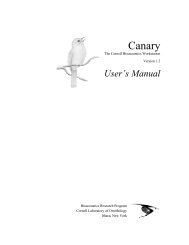An Atlas of Cerulean Warbler Populations - Cornell Lab of Ornithology
An Atlas of Cerulean Warbler Populations - Cornell Lab of Ornithology
An Atlas of Cerulean Warbler Populations - Cornell Lab of Ornithology
Create successful ePaper yourself
Turn your PDF publications into a flip-book with our unique Google optimized e-Paper software.
patches, the apparent sites <strong>of</strong> abandoned homesteads orfarms. Furthermore, several occupied areas along theDelaware represented forest strips within grassland orshrubland habitat, suggesting that structure <strong>of</strong> the forestcanopy was more important than extent <strong>of</strong> habitatpatches in this region. Virtually all occupied sites werein forest with canopy height > 15m.At present, the vast majority <strong>of</strong> <strong>Cerulean</strong> <strong>Warbler</strong>s inNJ are on public lands, both state and federally owned.Although these areas are under protection fromlargescale disturbance, specific management guidelinesfor <strong>Cerulean</strong> <strong>Warbler</strong>s do not exist, and importanthabitats (e.g. strips <strong>of</strong> riparian forest) are potentiallyvulnerable to recreational development. <strong>An</strong> importantexception is in the Northern Highlands region, wheremost birds occur on private land. In particular, the largestremaining population on Hamburg Mountain is currentlythreatened by development (Miranda).Number <strong>of</strong> occupied sitesRiparianbottomlandNJ Habitats (N=159)Mesicmixed oakOak-hickoryforestN. hardwoodforestFigure 20. Habitat classifications at sites with <strong>Cerulean</strong><strong>Warbler</strong>s in New Jersey. “N” equals number <strong>of</strong> occupiedsites with habitat data reported by CEWAP participants.New YorkThe <strong>Atlas</strong> <strong>of</strong> Breeding Birds in New York State (<strong>An</strong>drleand Carrol 1988) reported <strong>Cerulean</strong> <strong>Warbler</strong>s from 279(5%) atlas blocks statewide. The bulk <strong>of</strong> the distributionwas reported from the Lake Ontario Plain, withscattered populations south into the Finger Lakes, alongthe Southern Tier, and in the Hudson Valley and Highlands.<strong>An</strong>drle and Carrol, as well as Bull (1974) discussthe separate expansions <strong>of</strong> <strong>Cerulean</strong> <strong>Warbler</strong>s into NewYork from the Great Lakes to the west, and from NewJersey and Pennsylvania to the south.CEWAP participants documented 1,086 <strong>Cerulean</strong><strong>Warbler</strong>s at 246 (86%) <strong>of</strong> 286 sites surveyed in NewYork State (Map 21). Several areas proved to be important;however, four stand out because <strong>of</strong> exceptionalnumbers <strong>of</strong> birds. These include: the Montezuma NationalWildlife Refuge in Wayne, Seneca, and Cayugacounties; the Alleghany River-Salamanca region inCattaraugus County; the Galen Wildlife ManagementArea in Wayne County; and the Iroquois National WildlifeRefuge/Orchard Oak Wildlife Management Area inGenesee and Orleans counties. Combined, these fourareas accounted for 626 (58%) <strong>of</strong> the <strong>Cerulean</strong> <strong>Warbler</strong>scounted in the state (Table 13). Other importantareas included several sites in the Hudson Highlands <strong>of</strong>southeastern New York and Salmon Creek near CayugaLake.Of 240 sites where habitat data were reported, 184(77%) were classified as bottomland/riparian. Thesebottomland/riparian sites accounted for 773 (74%) <strong>of</strong>the <strong>Cerulean</strong> <strong>Warbler</strong>s observed. Forty-six sites wereclassified as dry slopes, accounting for 222 (21%) ceruleanobservations (Figure 21).For 215 sites reporting tree species, the most commonlyreported trees included maples, cottonwood, andoaks. Other important tree species at occupied sites includedash, American basswood, hickories, Americanbeech, black locust, and sycamore (Figure 22). In abreakdown by region <strong>of</strong> the state, bottomland sites inthe Montezuma and Iroquois region were dominated bycottonwood, silver and red maple, sycamore, and greenash. Sites in the Hudson Highlands were primarily whiteoak, American beech, sycamore, and ash, whereas sitesalong the Hudson River were predominantly cottonwoodand sycamore. Sites in the Allegany region were dominatedby white oak, red oak, chestnut oak, sugar maple,black cherry, and white ash. <strong>Cerulean</strong> habitat alongSalmon Creek in Tompkins County consisted <strong>of</strong> a diverseforest with sycamores, cottonwood, and black locustin the floodplain and red oak, basswood, and mapleson the surrounding slopes.Most <strong>of</strong> the <strong>Cerulean</strong> <strong>Warbler</strong>s in New York occuron publicly owned lands, with the largest populationson National Wildlife Refuges, State Parks, and StateWildlife Management Areas. <strong>An</strong> important exception isthe Salmon Creek population, which exists entirely onprivate lands. Following initial CEWAP surveys; however,the local Finger Lakes Land Trust became interestedin this site and has subsequently acquired severalsections <strong>of</strong> prime <strong>Cerulean</strong> habitat from willing sellers.The National Audubon Society <strong>of</strong> New York contributedto the conservation <strong>of</strong> this site by designating it anImportant Bird Area and providing support to the LandTrust. Nearly every site with breeding <strong>Cerulean</strong> War-(Continued on page 34)32
















